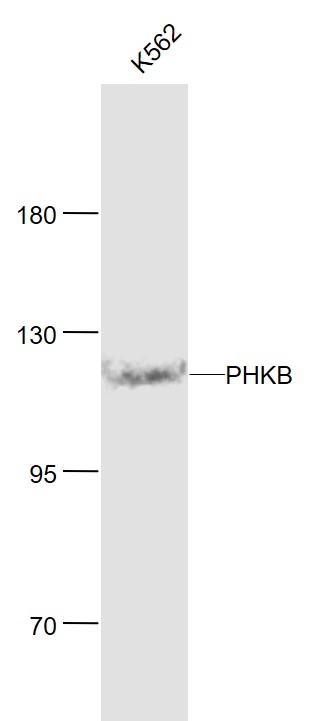
Rabbit Anti-PHKB antibody
Phosphorylase B; Phosphorylase kinase B; Phosphorylase kinase beta polypeptide; Phosphorylase kinase beta subunit; DKFZp781E15103; FLJ41698; KPBB_HUMAN.
View History [Clear]
Details
Product Name PHKB Chinese Name 磷酸化酶β抗体 Alias Phosphorylase B; Phosphorylase kinase B; Phosphorylase kinase beta polypeptide; Phosphorylase kinase beta subunit; DKFZp781E15103; FLJ41698; KPBB_HUMAN. literatures Research Area Tumour Cell biology immunology Kinases and Phosphatases Immunogen Species Rabbit Clonality Polyclonal React Species Human, (predicted: Mouse, Rat, Dog, Pig, Cow, Horse, Rabbit, ) Applications WB=1:500-2000 ELISA=1:5000-10000
not yet tested in other applications.
optimal dilutions/concentrations should be determined by the end user.Theoretical molecular weight 124kDa Cellular localization cytoplasmic The cell membrane Form Liquid Concentration 1mg/ml immunogen KLH conjugated synthetic peptide derived from human PHKB: 45-160/1093 Lsotype IgG Purification affinity purified by Protein A Buffer Solution 0.01M TBS(pH7.4) with 1% BSA, 0.03% Proclin300 and 50% Glycerol. Storage Shipped at 4℃. Store at -20 °C for one year. Avoid repeated freeze/thaw cycles. Attention This product as supplied is intended for research use only, not for use in human, therapeutic or diagnostic applications. PubMed PubMed Product Detail Phosphorylase kinase is a polymer of 16 subunits, four each of alpha, beta, gamma and delta. The alpha subunit includes the skeletal muscle and hepatic isoforms, encoded by two different genes. The beta subunit is the same in both the muscle and hepatic isoforms, encoded by this gene, which is a member of the phosphorylase b kinase regulatory subunit family. The gamma subunit also includes the skeletal muscle and hepatic isoforms, encoded by two different genes. The delta subunit is a calmodulin and can be encoded by three different genes. The gamma subunits contain the active site of the enzyme, whereas the alpha and beta subunits have regulatory functions controlled by phosphorylation. The delta subunit mediates the dependence of the enzyme on calcium concentration. Mutations in this gene cause glycogen storage disease type 9B, also known as phosphorylase kinase deficiency of liver and muscle. Alternatively spliced transcript variants encoding different isoforms have been identified in this gene. Two pseudogenes have been found on chromosomes 14 and 20, respectively.[provided by RefSeq, Feb 2010].
Function:
Phosphorylase b kinase catalyzes the phosphorylation of serine in certain substrates, including troponin I. The beta chain acts as a regulatory unit and modulates the activity of the holoenzyme in response to phosphorylation.
Subunit:
Hexadecamer of 4 heterotetramers, each composed of alpha, beta, gamma, and delta subunits. Alpha (PHKA1 or PHKA2) and beta (PHKB) are regulatory subunits, gamma (PHKG1 or PHKG2) is the catalytic subunit, and delta is calmodulin.
Subcellular Location:
Cell membrane; Lipid-anchor; Cytoplasmic side (Potential).
Post-translational modifications:
Ser-701 is probably phosphorylated by PKA.
Although the final Cys may be farnesylated, the terminal tripeptide is probably not removed, and the C-terminus is not methylated.
DISEASE:
Defects in PHKB are the cause of glycogen storage disease type 9B (GSD9B) [MIM:261750]; also known as phosphorylase kinase deficiency of liver and muscle (PKD). GSD9B is a metabolic disorder characterized by hepathomegaly, only slightly elevated transaminases and plasma lipids, clinical improvement with increasing age, and remarkably no clinical muscle involvement. Biochemical observations suggest that this mild phenotype is caused by an incomplete holoenzyme that lacks the beta subunit, but that may possess residual activity.
Similarity:
Belongs to the phosphorylase b kinase regulatory chain family.
SWISS:
Q93100
Gene ID:
5257
Database links:Entrez Gene: 5257 Human
Entrez Gene: 102093 Mouse
Omim: 172490 Human
SwissProt: Q93100 Human
SwissProt: Q7TSH2 Mouse
Unigene: 78060 Human
Unigene: 237296 Mouse
Unigene: 6488 Rat
磷酸化酶A是磷酸化酶的活性状态,而磷酸化酶B是其无活性状态。6-磷酸葡萄糖结合磷酸化酶后,磷酸化酶由无活性变为活化态,的加长,之后,又回到原来无活性状态,它充当了个桥梁作用。Product Picture
References (0)
No References
Bought notes(bought amounts latest0)
No one bought this product
User Comment(Total0User Comment Num)
- No comment



 +86 571 56623320
+86 571 56623320
 +86 18668110335
+86 18668110335

